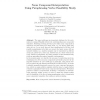Free Online Productivity Tools
i2Speak
i2Symbol
i2OCR
iTex2Img
iWeb2Print
iWeb2Shot
i2Type
iPdf2Split
iPdf2Merge
i2Bopomofo
i2Arabic
i2Style
i2Image
i2PDF
iLatex2Rtf
Sci2ools
AIMSA
2008
Springer
2008
Springer
Noun Compound Interpretation Using Paraphrasing Verbs: Feasibility Study
Abstract. The paper addresses an important challenge for the automatic processing of English written text: understanding noun compounds’ semantics. Following Downing (1977) [1], we define noun compounds as sequences of nouns acting as a single noun, e.g., bee honey, apple cake, stem cell, etc. In our view, they are best characterised by the set of all possible paraphrasing verbs that can connect the target nouns, with associated weights, e.g., malaria mosquito can be represented as follows: carry (23), spread (16), cause (12), transmit (9), etc. These verbs are directly usable as paraphrases, and using multiple of them simultaneously yields an appealing fine-grained semantic representation. In the present paper, we describe the process of constructing such representations for 250 noun-noun compounds previously proposed in the linguistic literature by Levi (1978) [2]. In particular, using human subjects recruited through Amazon Mechanical Turk Web Service, we create a valuable manua...
AIMSA 2008 | Artificial Intelligence | Noun Compound Interpretation | Noun Compounds | Paraphrasing Verbs |
| Added | 01 Jun 2010 |
| Updated | 01 Jun 2010 |
| Type | Conference |
| Year | 2008 |
| Where | AIMSA |
| Authors | Preslav Nakov |
Comments (0)

